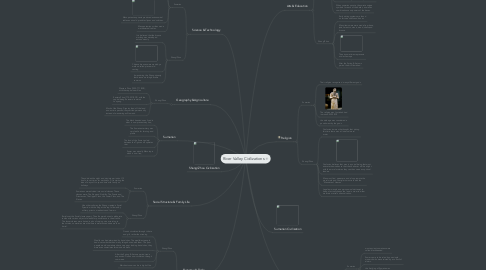
1. Sumerian
1.1. The black headed ones lived in what is now present day Iraq
1.2. The Sumerian territory was very fertile for farming and plants
1.3. The land of the Sumerian laid between the Tigris and Euphrates river
1.4. Sumer was actually Mesotopia which is now Iraq
2. Geography & Agriculture
2.1. Shang/Zhou
2.1.1. Western Zhou (1050-771 BCE), with the capital near Xian
2.1.2. Eastern Zhou (770-221 BCE), with the capital being Eastward towards Luoyang
2.1.3. Much of the Shang Dynasty lived off the land and as time passed, they settled permanently instead of wandering as Nomads.
3. Social Structure & Family Life
3.1. Sumerian
3.1.1. They divided the night and day into periods of 12 hours, to set times for work days. First starting the idea of days off to spend time with family on holidays
3.1.2. Sumerians were divided into social classes. These classes were: The King and Nobility, The Priests and Priestesses, The Upper Class, the Lower Class, and The Slaves.
3.2. Shang/Zhou
3.2.1. Like other cultures, the Shang created a Social Pyramid with the King at the top followed by military, priests, merchants and farmers.
3.2.2. Burials set the Social classes apart. The elite were buried in elaborate tombs with various object of wealth for possible use in the afterlife. The lesser classes were buried in pits of varying size according to their status, sometimes even the lowest were tossed down wells as burial.
4. Economy & Trade
4.1. Shang/Zhou
4.1.1. Goods circulated through tribute and gift, rather than trading
4.1.2. Wealth can be determined by burial sites. The wealthiest people had nice tombs that had many things buried with them. The poor people would sometimes have very poor looking burial sites; they were even sometimes thrown down wells.
4.1.3. After the Spring & Autumn period trade expanded. Goods now circulated through commerce.
4.1.4. Merchants now can be in high office.
4.2. Sumerian
4.2.1. The sumerians called themselves the 'Black Head People'
4.2.2. Uruk (one of the sumerian cities) was known to be one of the first cities in the world.
4.2.3. The city-states of sumer fought for control of arable land and water rights until the vise of the first dynasty.
4.2.4. Under snuglis reign, a wall was constructed 155 miles to keep out the semitic-speaking tribes.
5. Science & Technology
5.1. Sumerian
5.1.1. Sumerians developed scientific knowledge through close observation of the natural world.
5.1.2. They developed theorems on how to measure the area of several shapes and solids.
5.1.3. Mesopotamian priests produced astronomical tables and could predict eclipses and solstices.
5.1.4. Mesopotamian scribes made mathematical tables.
5.2. Shang/Zhou
5.2.1. It is believed that the bronze working was developed autonomously
5.2.2. Chinese bronzes were made by a method called piece-mold casting
5.2.3. It was during the Shang dynasty that bronze working became common
6. Shang/Zhou Civilization
7. Religion
7.1. Sumerian
7.1.1. Their religion recognised many different gods
7.1.2. The religion was first inhabited in around 4500 BCE
7.1.3. the dark age was considered a punishment by the gods.
7.2. Shang/Zhou
7.2.1. Confucianism was the thought that during this time there was a Universal moral order.
7.2.2. Confucius believes that man is a social being that must educate themselves so that their behavior will be alright with the moral order an they can then serve as spiritual leaders.
7.2.3. Men must find, persevere, and also promote the morals rule and that rulers must rule with the "Mandate of Heaven".
7.2.4. Legalism was when a person would attempt to keep of actually keeps the laws in order to either maintain or attain ones salvation.
8. Government & Leaders
8.1. Sumerian
8.1.1. most ancient sumarians were called black headed.
8.1.2. Sumer came to be ruled by one single monarch who was assisted by a council of elders.
8.1.3. the first king of Sumeria was named Etana of Kish
8.1.4. in the dynastic period Sumerians shifted from a priest-king to a more modern-day concept of a king. A priest king was known as an ensi and a modern day king was a lugal.
8.2. Shang/Zhou
8.2.1. King Wen (1152-1056 BCE). He became King in 1099 BCE during the last days of the Shang Dynasty. Wen is credited by making alliances with neighboring cheif's that gave Zhou the military power and strength to make conquest possible.
8.2.2. The King retreated to his home and committed suicide by setting his home on fire and locking himself inside. King Wu did not exterminate the Shang entirely. He left the Shang city of Youli to one of his brothers to keep it under control.
8.2.3. Any local leader who challenged the Zhou order was quickly punished by the army and the regional delegates were also closely watched.
9. Arts & Education
9.1. Sumerian
9.1.1. 5,000 years ago sumerians developed a writing system which encompass both logophonetic, consonantal alphabetic and syllabic systems become known as cuneiform.
9.1.2. Clay tokens that were made of abstract shapes were used for counting agriculture and manufactured goods.
9.1.3. The sumerian writing system during the early periods were constantly flux, the original direction of writing was from top to bottom.
9.1.4. When sumerians wrote, they wrote unique symbols for each of the bases, as well as combinations and powers of the bases.
9.2. Shang/Zhou
9.2.1. Early writing systems are found on tortoise shells and bones.
9.2.2. Many items were were made from bone, jade,ceramics, stone, wood, shells,and bronze
9.2.3. The art sometimes represents mid-evil europe
9.2.4. After the Spring & Autumn period the arts flourished.
